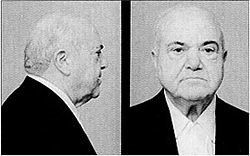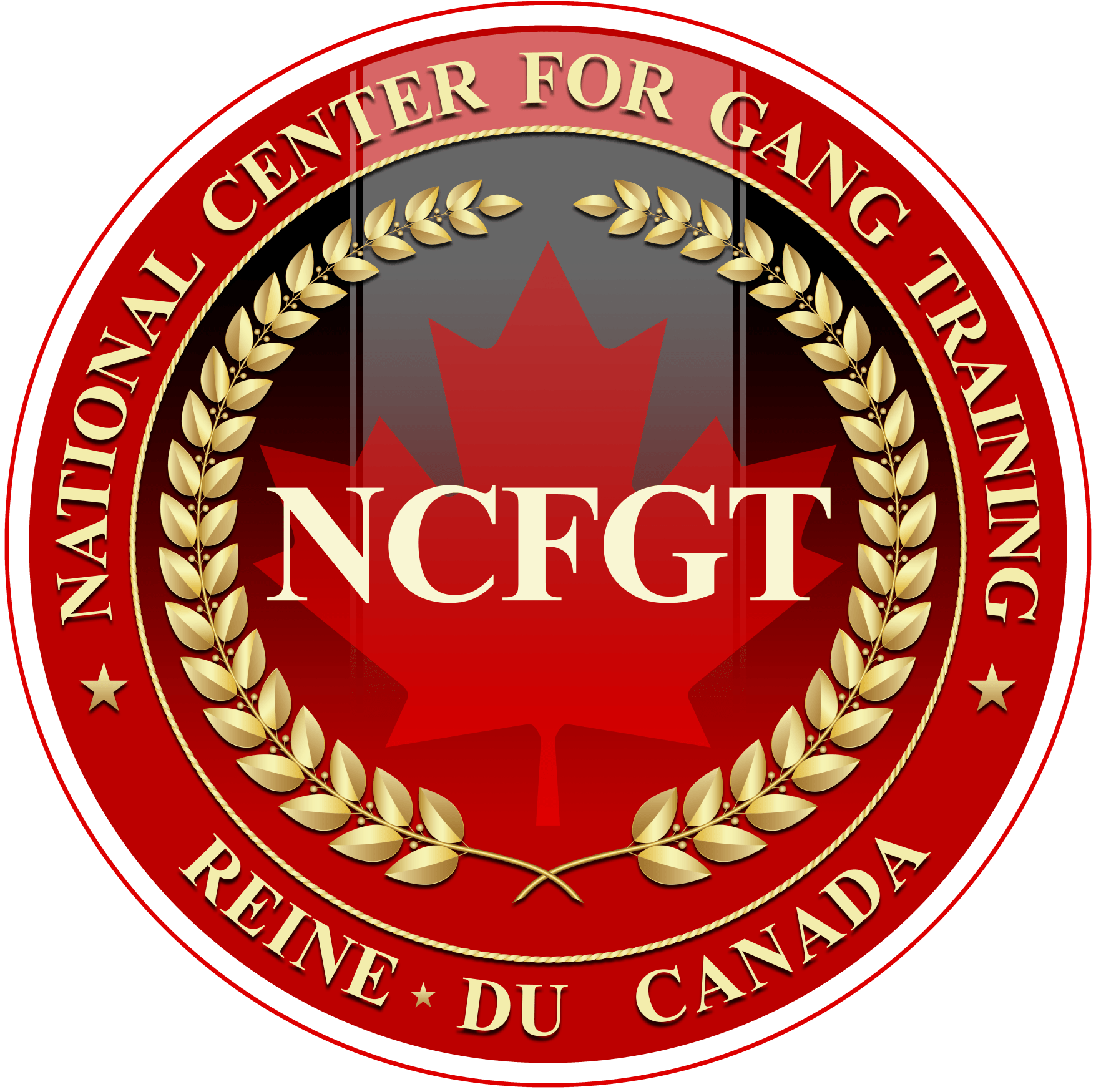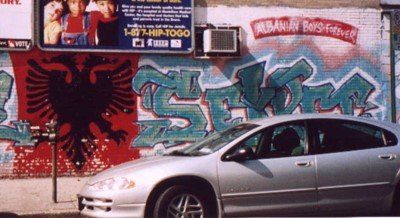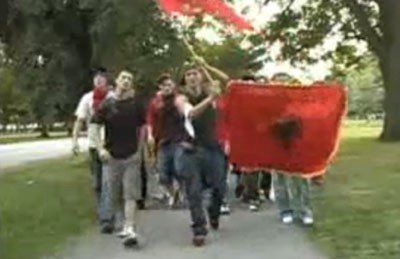Albanian mob pt.1 NY Intro
A graffiti mural in Albanian featuring the double-headed eagle, off Lydig Ave. in the Bronx.
Mar. 11, 2011
It's not every day that two weed dealers from New York City face the death penalty.
These two are a pair of Albanian-American brothers from Staten Island named Saimir and Bruno Krasniqi, ages 29 and 26. They, along with a 27-year-old partner named Almir Rrapo—who was a civil servant in Albania, working for a deputy prime minister at the time of his arrest—led a crew of 15 other men. The other members of their crew were Albanian, too.
I first heard about Albanians and the street in the mid 1980s. They tore through the Westchester County Fair at Yonkers Raceway with baseball bats over some type of beef. They were just beginning to make a name for themselves here for craziness. Do not fuck with the Albanians was quickly becoming conventional wisdom.
New York City has the largest Albanian population in the United States, and for 25 years a small number of them have been popping up in spectacular ways on the blotter: shooting up Scores strip club; putting a hit out on Giuliani and his prosecutor; employing an active-duty cop for crime jobs; muscling in on and pulling guns on the Gambino family during a sit-down at a gas station (allegedly); demanding John Gotti's old table at Raos (allegedly). Plaurent "Lenti" Dervishaj, the most-wanted fugitive in his native Albania, the alleged head of an organized-crime syndicate, is on the federal authorities' most-wanted list for New York City. (Among other things, he had rocket launchers.)
Albanian gangsters maintain a serious presence in Europe and a serious reputation among people who study transnational organized crime. They get shouted out in Grand Theft Auto.
We all should know this, but it has to be said: This is just one story about one aspect of a community, and a people. Mother Teresa was Albanian. So was the kind lady in the bakery in the Bronx who schooled me on burek and sudjuk, and so was the man who took me into his home when I rang his bell out of the clear blue at night after bouncing around Albanian businesses in Staten Island all day and depositing a long letter into the Krasniqi family mailbox.
Walking through some sketchy urban blight I stumbled upon and into a large building housing the very substantial Albanian-American Institute.
Albania is a small country but special in some unfortunate ways, not least of which is the presence of a significant political-criminal syndicate within the government.
It's a prime transit zone for heroin, situated on the way from Afghanistan, where all dope comes from, and Europe, considered to be the most lucrative market in the world. The product goes from Afghanistan to Iran to Turkey and then to the Balkans where “interception efficiency drops significantly…the route is exceedingly well organized and lubricated with corruption,” according to the The World Drug Report 2010, produced by the United Nations Office on Drugs and Crime. The report also notes that “…important networks have clan based and hierarchically organized structures. Albanian groups in particular have such structures making them particularly hard to infiltrate.” There is an old Albanian tradition of families and clans (fins, fares) and a code of honor (besa) that criminals appropriate and corrupt.
Albania also has been a very significant corridor for human trafficking (sex work) and smuggling of migrants. Ethnic Albanians are also heavily involved in the fake-passport industry.
There’s reportedly mass production of marijuana there; the government is considered to be statistically one of the most corrupt in the world. (Ilir Meta, the minister Rrapo worked for, recently resigned and is being investigated.) Close to 50 percent of Albania's young men (the 15- to 24-year-olds, the prime age of lawbreakers) are unemployed. A significant amount of money made illegally by Albanians abroad is sent back home, where, according to reports, it can be laundered.
IN AUGUST 2010 THE U.S. ATTORNEY'S OFFICE IN MANHATTAN unsealed a 37-page indictment against the "Krasniqi Organization" (which is almost certainly not what they called themselves). The FBI, which has a standing Albanian Organized Crime Task Force, and the New York Joint Organized Crime Force conducted the operation. Court records indicate they have hours of tape of the defendants talking, in Albanian.
The charges are murder, kidnapping, assault, narcotics trafficking, robbery, extortion, arson, obstruction of justice, and interstate transportation of stolen goods. All were charged in the aid of a racketeering enterprise. Some members were arrested in Canada. Almir Rrapo was extradited from Albania (where he fled weeks after the Shehu murder, according to the prosecutor's filings) only when the government agreed to take the death penalty off the table.
In the indictment, the crew is alleged to have smuggled marijuana over the border from Canada into Detroit (significantly, they’re charged with operating in the Eastern District of Michigan; more on this later) and Buffalo and then couriered it to New York.
The Krasniqis are supposed to have moved and distributed more than 100 kilos of marijuana. The authorities are seeking millions in asset forfeitures. Three of the crew were on unemployment.
One of the defendants, Elton Sejdaris (known as "Tony"), pled guilty to seven very heavy-duty counts and is supposedly cooperating with the prosecution. He’s not in the federal inmate locater system and his lawyer no-commented me forcefully and repeatedly. His location is super-secret, like much else in this case.
THERE ARE ALBANIAN NEIGHBORHOODS ON EITHER SIDE of East Fordham Road in the Bronx: Pelham Parkway on one side, the Belmont section on the other. (There are smaller concentrations of Albanians on Staten Island, in Brooklyn and in Queens.) It's an area where you can pick up copies of Illyria newspaper, where you see the double-headed eagle flag fly on rearview mirrors and the stickers proudly advertising "The World’s Newest Country," Kosovo.
It’s where you walk into cafés and drink strong espresso in the middle of the day as strong-looking adult men do their social-club thing. It’s where the 40-something in a track suit schools me on the food and culture, where the younger Albanian homeboys with ball caps and sneakers talk about cars doing 180 m.p.h and their dreams of opening up a pizzeria one day.
All that is color, like the nicknames of the Krasniqi crew, which were dutifully recorded in the indictment: Neri, Cuz, Naz, Genti, Berti, Duke, Miri.
These are the facts, according to the government: In 2005 Erion Shehu was shot and killed in a drive-by in Queens, allegedly by the Krasniqis and Rrapo. Nineteen shots, seven hits. There were gambling receipts on his person and a gun in his car.
Six months after this (court records talk about the Krasniqi brothers' habit around this time of sticking guns into people’s mouths to threaten them), the Krasniqis shot Erenick Grezda in the head and dumped him on the side of the Brooklyn-Queens Expressway.
Grezda was around 22. He came from Albania as a teenager without his parents. He lived in Bensonhurst with some roommates. His uncle said he knew him since he was a little boy. A normal kid, he said. He changed when he got older. He worked in construction a little, was always struggling financially. His uncle helped him out. His uncle was the one who identified him at the morgue. Two gunshots to the head. His uncle flew with his body back to Albania so his parents could bury him. The uncle said the FBI came around then about the murder, and they came around recently about the trial. It seems nobody from Grezda’s family will be attending.
In part of his guilty plea, Sejdaris said that he was in the car when Grezda’s murder took place (apparently his guns were used; court records indicate he was charged with possession of a machine gun). It was also Sejdaris’ car and it was torched to get rid of evidence. He was reimbursed for it. Sejdaris told the court that they used to call Grezda “Eri” for short; it seems they were friendly. They were all boys at one point.
They were such boys that they were together with the others in on the Shehu killing. Friends told the court that Grezda later laughed about it.
AROUND 2005, GREZDA WAS KIDNAPPED BY A RIVAL ALBANIAN gang the Krasniqis had ripped off. Bruno was kidnapped, too, by four masked men—the same ones who had taken Grezda.
They were driven to Michigan.
Grezda was beaten so badly he could barely walk. He gave up the Krasniqis as the robbers. He was left bloody and naked in downtown Detroit. A good samaritan put him on a bus to New York.
Meanwhile, Bruno called Saimir, who was living in Michigan at the time (the Eastern District) and told him that he had to pay a $350,000 ransom for his life. Saimir, supposedly in the crime game since 2003, and having just killed someone four months earlier (Shehu), called the FBI.
A news account from the time says that the Bureau mobilized 50 agents. Saimir cooperated in a sting and they arrested the bagman during the money drop-off. The bagman, a political asylum seeker and restaurant worker, Franc Shestani, refused to cooperate, reportedly saying “just go ahead and shoot me now.” Bruno was later dropped off in a gas station along I-75. (According to the most recent court records, from January of this year, the men directly involved with the kidnapping were never arrested.)
Around this same time, very near where Saimir was living in Michigan, rival Albanian gangs were terrorizing Oakland and Macomb Counties, hanging around a coffee shop named Goodfellows (there’s one a couple blocks from Krasniqi’s house in Staten Island also—no relation, apart from the media-mafia culture thing), making people beg for their life at gunpoint, planning at one point to ride in on motorcycles with AK-47s to settle a dispute.
The purported leader of one of the gangs, Ketjol Manoku, 26, used a nine millimeter to shoot four other Albanians in a minivan. (All this was going on literally in Eminem and Kid Rock territory, in Marshall Mathers’ hometown—young, white men just outside of the inner city, living a hard knock lifestyle a few cultural, racial, and geographical clicks from the pull, influence, aspirations of the ghetto gangster scene on the other side of 8 Mile Road.)
Manoku and two other Albanian twenty-somethings are now doing multiple life sentences in Michigan state prisons. The three of them also had federal indictments and affidavits for participating in a criminal enterprise. Manoku’s lawyer then, Henry Scharg, is now Bruno Krasniqi’s lead attorney today.
Two months after the whole kidnapping, FBI sting went down in Michigan, the Krasniqis murdered their boy Erenick Grezda in New York in retaliation.
When the charges were issued, Manhattan U.S. Attorney Preet Bharara made this statement: "Today, nearly five years after the brutal murders of Erion Shehu and Erenick Grezda, we announce the indictment of individuals allegedly responsible for these heinous crimes. This case reminds us that, despite the increasingly global nature of organized crime, its dangers are right here on our city streets."
The FBI unit supervisor in New York added that the Brooklyn neighborhood where one of the defendants (Florian Veshi) lived would now be a safer place.
Bruno Krasniqi’s other attorney, Kelley Sharkey, politely told me to leave him alone. (I wrote to Bruno and Saimir in jail; the letter laid out exactly who I was and what I wanted to do.) She told me not to try and continue making contact with his family. She said it was an open case and she couldn’t speak about it. I understand, I told her. I wasn't sure whether it was appropriate to wish her luck.
Sharkey has defended a Gambino hit man and has been publicly hated by a law enforcement association. She defended a Staten Island banger who killed two undercover detectives, one of them as he pled for his life. She asked a jury to show him mercy, mercy he himself didn’t show; she asked each of them to be a better person than her client was. The reporter in the courtroom wrote that her voice broke, and that she cried for a second. She wasn't just doing her job, he said.
Sharkey told me wishing good luck is fine.
The trial for the drug charges is scheduled to start on May 23. A separate trial on the racketeering charges, involving both the Krasniqis and a rival crew, will begin in October. I’ll attend both.
Some people I've talked to in the course of reporting this story have asked, pointedly, why any of this is interesting, and why it's worth writing about. There are tens of thousands of Albanians in New York working multiple jobs, raising children and going to church.
Two young men are dead, two more men might be executed. At least 16 other young men will spend years, maybe the rest of their lives, in cages. There are surely many mothers and fathers crying, girlfriends and wives devastated, families wrecked.
It happens all the time, I’ve been told. It’s a valid point.
My answer is that not to bother to try to explain why and how it all happened is like not having a proper funeral service for the dead, and that telling the story is a way of showing we’re better than those who don’t or can’t give a damn about their own lives, or other people's.




